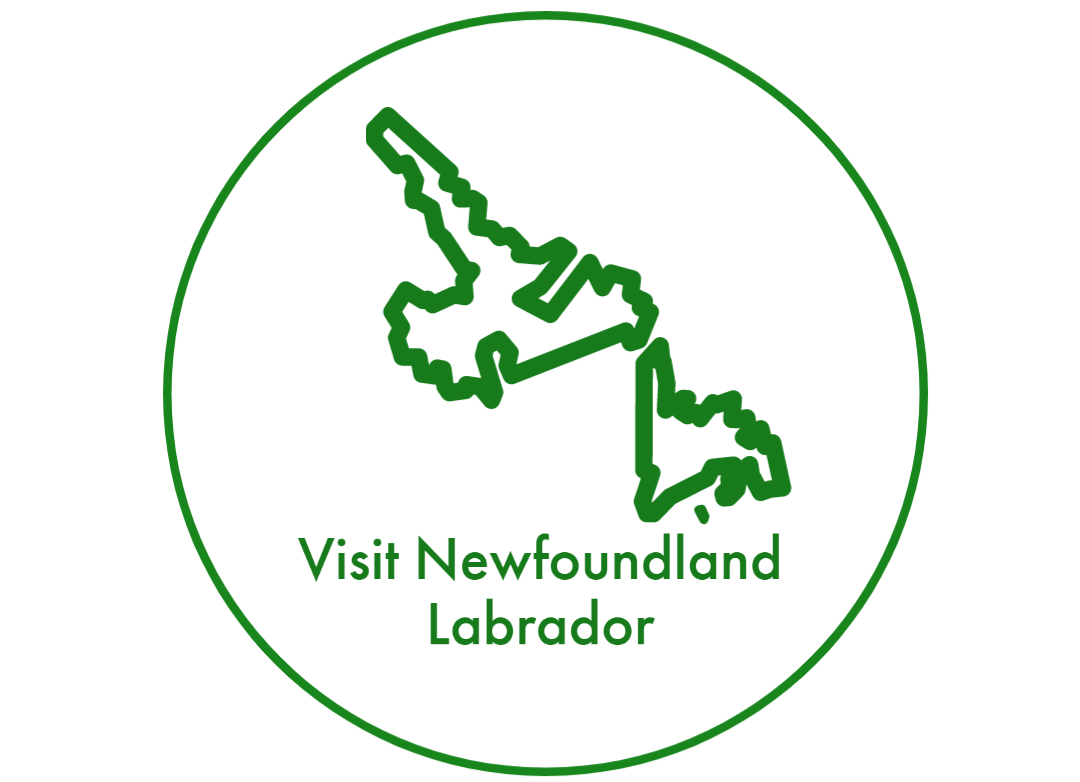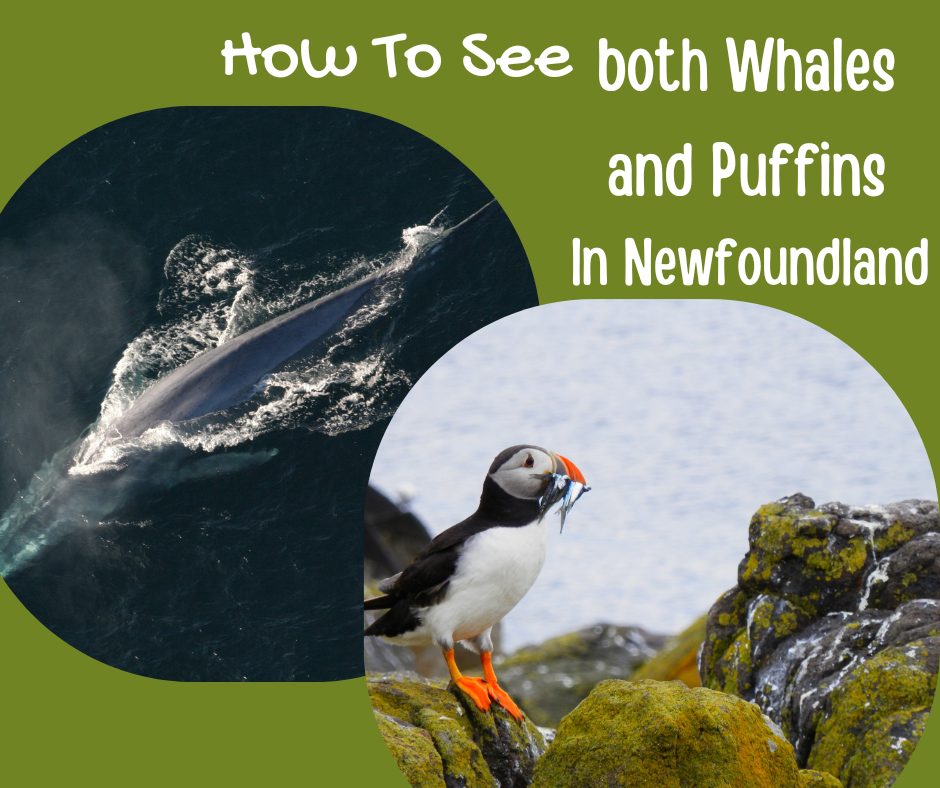How To See both Whales and Puffins in Newfoundland
This is How To See both Whales and Puffins in Newfoundland. Newfoundland is a fantastic place to visit. It has breathtaking scenery, friendly people and excellent food. However, if you’re looking for something unique, you should try seeing whales and puffins in Newfoundland. This sounds like it would be impossible, but it’s not complicated.
When can you see whales in St. John’s, Newfoundland? Whale sightings in St. John’s are most common from June to September, with peak activity occurring in July and August. During this time, various whale species can be observed in the waters off the coast, including humpback whales, minke whales, fin whales, and occasionally orcas (killer whales). Boat tours and excursions dedicated explicitly to whale watching are available from St. John’s, providing the opportunity to witness these majestic marine mammals in their natural habitat.
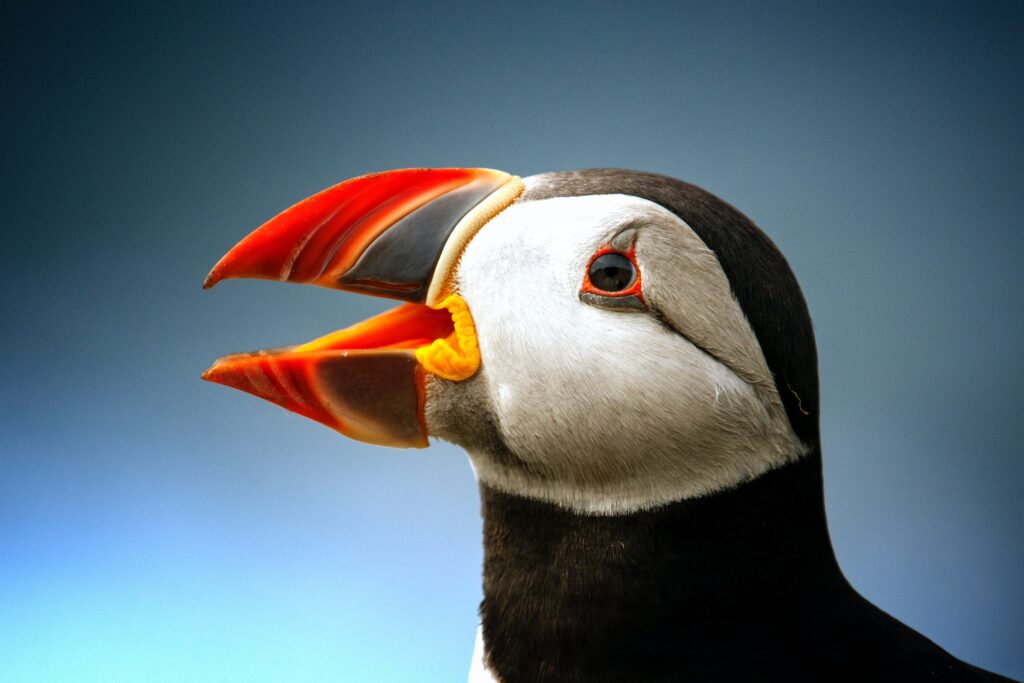
There is nothing like going on an Atlantic Puffin tour in Newfoundland.
Atlantic puffins are one of the most colourful birds in the world. They are also easy to spot and enjoy on a boat tour in Newfoundland. The best way to see Atlantic puffins is by going out on an Atlantic Puffin tour with a guide who knows where they like to nest and feed. Puffins can be seen all over Newfoundland, but they prefer rocky coasts with large colonies of other seabirds, such as gulls or murres (smaller diving birds).
On these tours, you’ll see thousands upon thousands of Atlantic Puffins flying around, doing their best – eating fish and feeding their young ones. They dive into the water from heights up to 10 feet high or from the surface to catch their prey underwater, then fly back up without wetting their feet. It’s unique how these little guys survive and thrive, living so close together without fighting over food resources as some other species would do.
The puffins are best seen during the summer when you can witness them breeding on land.
Puffins are most commonly seen during the summer when you can witness them breeding on land. Puffins are land birds and spend most of their time on land and sea. They only come to the water to fish for small fish or squid. During this time, it’s possible to see puffin colonies around Newfoundland and Labrador.
The best place to see Atlantic puffins is at Witless Bay Ecological Reserve and Elliston, where several nesting sites are along the coast. Puffins build nests from grasses and twigs collected from nearby beaches and grassland before laying their eggs inside them. Each nest usually holds one egg but sometimes two if there aren’t enough suitable spots nearby for nesting.
After hatching out into chicks, these little ones stay close together until they leave home around four weeks later. However, since they’re still young enough and unable to fly properly, their care must be carried out by either parent wherever needed until they take their first flight. Puffins have bright orange beaks and feet, which are meant to be seen from a distance and warn predators that they taste bad. Puffins also have bright colours so they can attract mates.
During the nesting season, you can see their brightly coloured bills and legs.
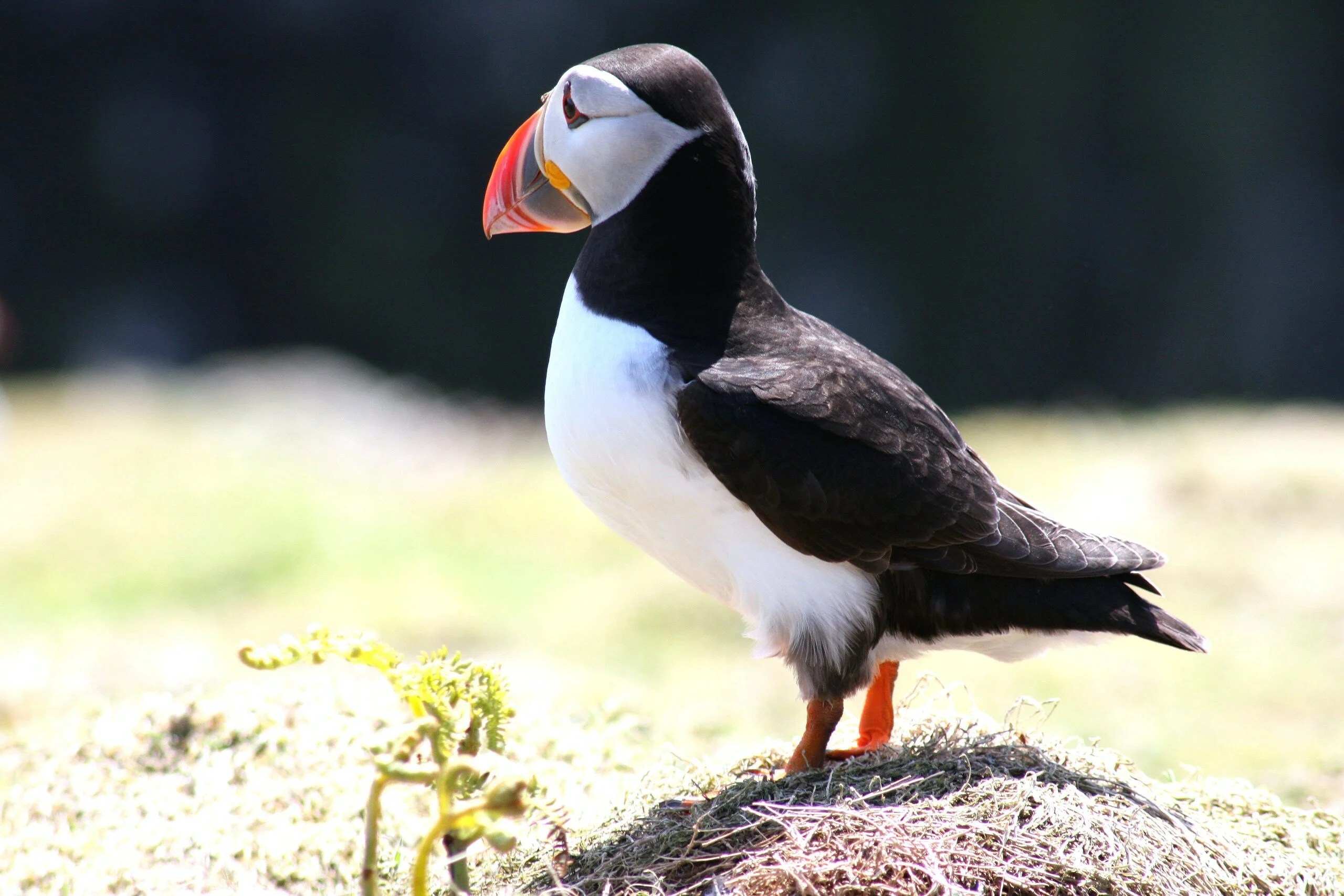
Puffin is a short-tailed, stocky seabird with a large head and bill, white eyelids and a black stripe above its eye. During the breeding season, you can see their brightly coloured bills and legs. Puffins nest on rocky cliffs or stacks off the coast of Newfoundland and Labrador.
Puffins are most commonly found offshore during winter, but they migrate during spring to the coast, where there is enough food to feed.
More Questions About Puffins in Newfoundland:
What is the population of Puffins in Newfoundland?
The population of Puffins in Newfoundland is estimated to be over 500,000 individuals. These seabirds are commonly found along the coastlines of Newfoundland, particularly on islands like Witless Bay, Funk Island, and St. Mary’s Bay. Puffins are known for their distinctive appearance with black and white feathers, colourful beaks, and a comical way of walking. They nest in burrows and cliffs, and during the breeding season, visitors can witness their unique courtship displays and the raising of their chicks.
Where can I see Puffins in Newfoundland?
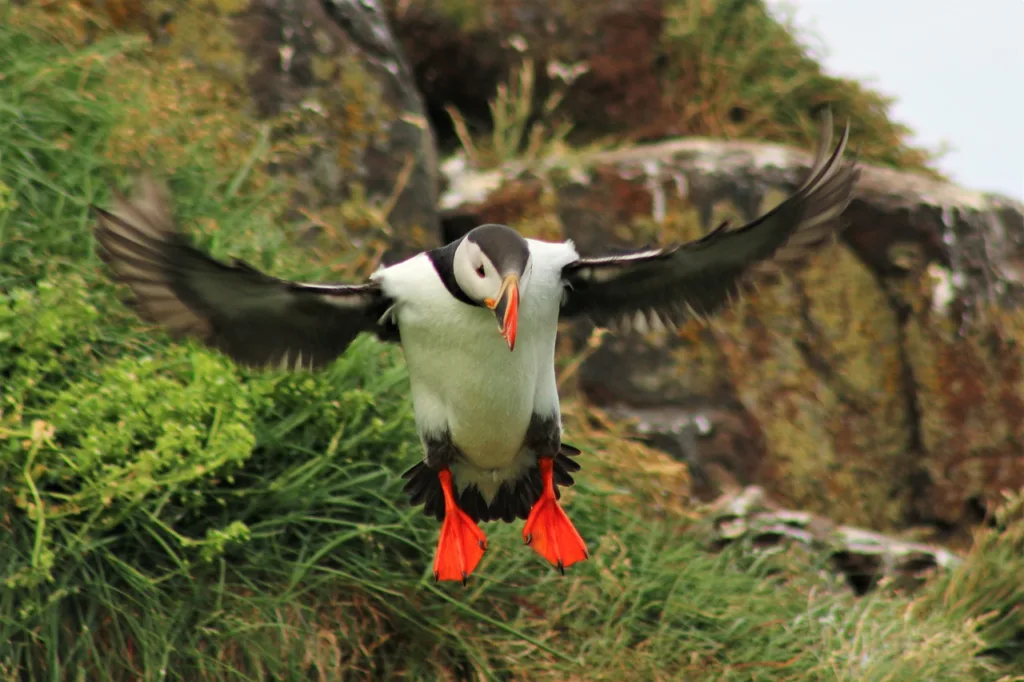
To observe Puffins in Newfoundland, there are several locations you can visit. One of the most popular spots is Witless Bay Ecological Reserve, located near St. John’s. This reserve is home to North America’s largest colony of Atlantic Puffins. Other places to see Puffins include Elliston, Cape St. Mary’s Ecological Reserve, and Bonavista Peninsula. Plan your visit during the summer when the Puffins are nesting and most active. Remember to respect the birds’ natural habitat and follow any guidelines provided by park authorities.
What do Puffins eat in Newfoundland?
Puffins in Newfoundland primarily feed on small fish, such as capelin, herring, and sand lance. They have specialized bills that allow them to catch multiple fish at once, making them efficient hunters. Puffins can dive underwater in search of their prey. They use their wings to propel themselves underwater, swimming and pursuing their meals. Depending on availability, these seabirds are also known to consume shrimp, squid, and other marine invertebrates. Their diet is crucial in maintaining their health and supporting their breeding activities.
How long do Puffins stay in Newfoundland?
They stay in the region throughout the breeding season until August or September. Puffins build their nests, lay eggs, and raise their chicks during this time. After the breeding season, they leave Newfoundland and migrate to the open ocean, spending the winter months far from land. Puffins are known for their impressive navigational skills, returning to the same breeding colonies each year to reunite with their mates and raise a new generation.
Do Puffins migrate from Newfoundland?
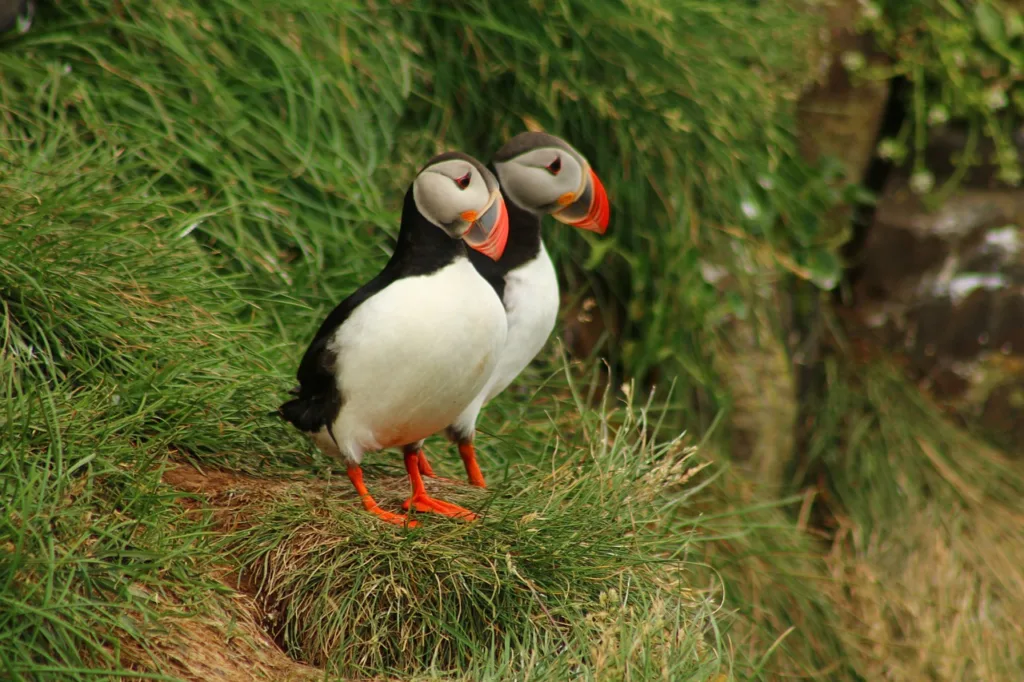
Yes, Puffins in Newfoundland are migratory birds. After the breeding season, which typically ends in August or September, they leave the coastal regions of Newfoundland and embark on their annual migration. Puffins from Newfoundland migrate to the open ocean, where they spend the winter months. The exact migration routes and destinations of Newfoundland Puffins vary, but they generally move southward, following food availability. These migratory journeys can span hundreds or even thousands of kilometres.
Can Puffins fly long distances in Newfoundland?
Puffins in Newfoundland can fly long distances when they are not nesting. During the breeding season, Puffins primarily use their wings for swimming and diving rather than sustained flight. However, once the breeding season ends and they leave their nesting colonies, Puffins take to the skies and embark on their migratory journeys. They can fly for extended periods, covering considerable distances to reach their wintering grounds in the open ocean. Puffins are well-adapted for flight, with compact bodies, mighty wings, and aerodynamic shape. Their flight allows them to access new foraging areas and adapt to changing environmental conditions.
How do Puffins build their nests in Newfoundland?
Puffins in Newfoundland build their nests in burrows, crevices, or rocky cliffs near the coast. They prefer locations that protect them from predators and harsh weather conditions. Puffins are excellent excavators and use their sharp bills and sturdy claws to dig burrows in the soil or create nest ledges on cliffs. They may use existing holes or modify them to suit their needs. Inside the nest, Puffins create a chamber where they lay their eggs and incubate them. The nests are often lined with grass and feathers to provide comfort for the eggs and, later, the chicks.
Do Puffins return to the same nest in Newfoundland?
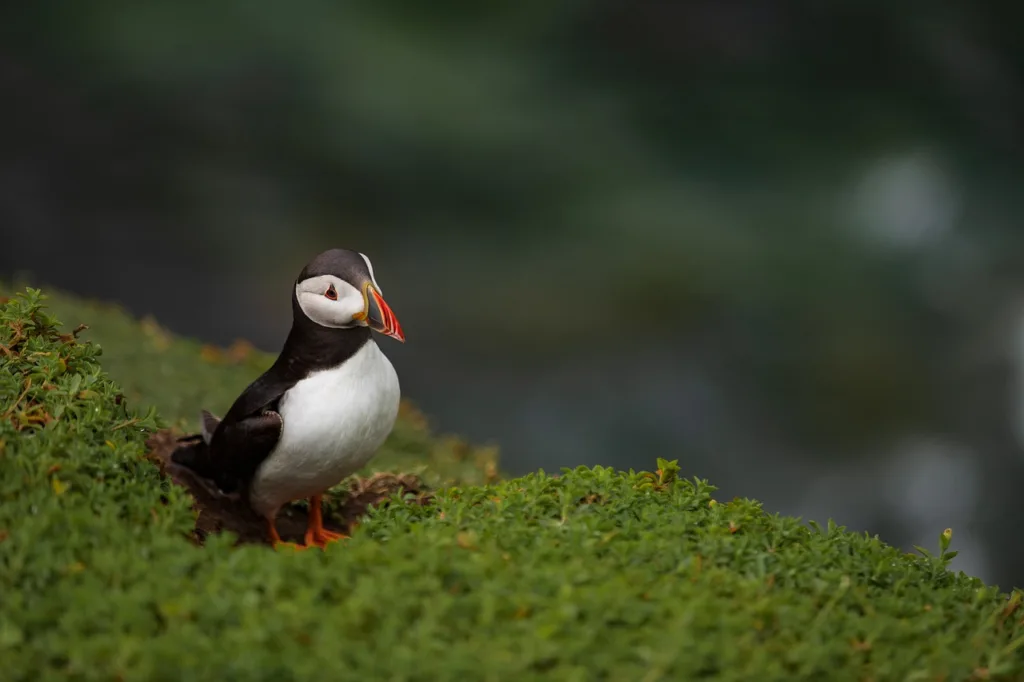
Yes, Puffins in Newfoundland have strong fidelity to their nesting sites and often return to the same burrow or nest ledge each breeding season. This behaviour is known as site fidelity. Puffins can remember and locate their nesting sites, even after spending months at sea during the winter. This fidelity to their nests helps ensure the continuity of breeding colonies and allows Puffins to reunite with their mates each year. However, if a nesting site becomes unsuitable or unavailable, Puffins may seek out alternative locations in their search for a suitable breeding site.
Can I touch or approach Puffins in Newfoundland?
Maintaining a respectful distance and avoiding touching or approaching Puffins in Newfoundland is important. These seabirds are wild animals and should be observed from a distance to minimize disturbance to their natural behaviours. Getting too close or disturbing their nesting sites can cause stress and potentially lead to abandoned nests or disrupted breeding activities. Many areas where Puffins nest, such as ecological reserves and protected sites, have specific guidelines to protect the birds and their habitats. Following these guidelines and observing Puffins responsibly is crucial, allowing them to thrive in their natural environment.
Are there guided tours to see Puffins in Newfoundland?
Yes, there are guided tours available in Newfoundland that offer the opportunity to see Puffins up close while respecting their natural habitat. Boat tours are often led by knowledgeable guides who can provide insights into Puffins’ behaviour, biology, and conservation. Witless Bay Ecological Reserve, located near St. John’s, is a popular destination for guided Puffin tours. These tours typically take visitors on boat trips to the Puffin colonies, providing an unforgettable experience of witnessing these charismatic seabirds in their natural environment. Booking a guided tour ensures a safe and educational visit to observe Puffins while minimizing disturbance to their nesting sites.
Can I take photographs of Puffins in Newfoundland?
Yes, you can take photographs of Puffins in Newfoundland, as long as it is done without causing any disturbance or harm to the birds. When photographing Puffins, it’s important to maintain a respectful distance and use telephoto lenses or optical zoom to get close-up shots without intruding on their space. Avoid using flash photography, as it can startle or disorient the birds. By practicing responsible photography, you can preserve your memories of these enchanting seabirds while promoting their conservation and well-being.
What is the significance of Puffins in Newfoundland’s ecosystem?
Puffins play a significant role in Newfoundland’s ecosystem. As seabirds, they contribute to the marine food web by feeding on small fish and invertebrates, helping maintain balance in the ecosystem. Puffins also serve as indicators of the overall health of the marine environment. Changes in population size or breeding success can reflect shifts in food availability or environmental conditions. Additionally, Puffins contribute to coastal biodiversity and provide opportunities for ecotourism, attracting visitors who come to witness these unique and charming seabirds. Conserving Puffins and their habitats is crucial for preserving the ecological integrity of Newfoundland’s coastal ecosystems.
How can I support the conservation of Puffins in Newfoundland?
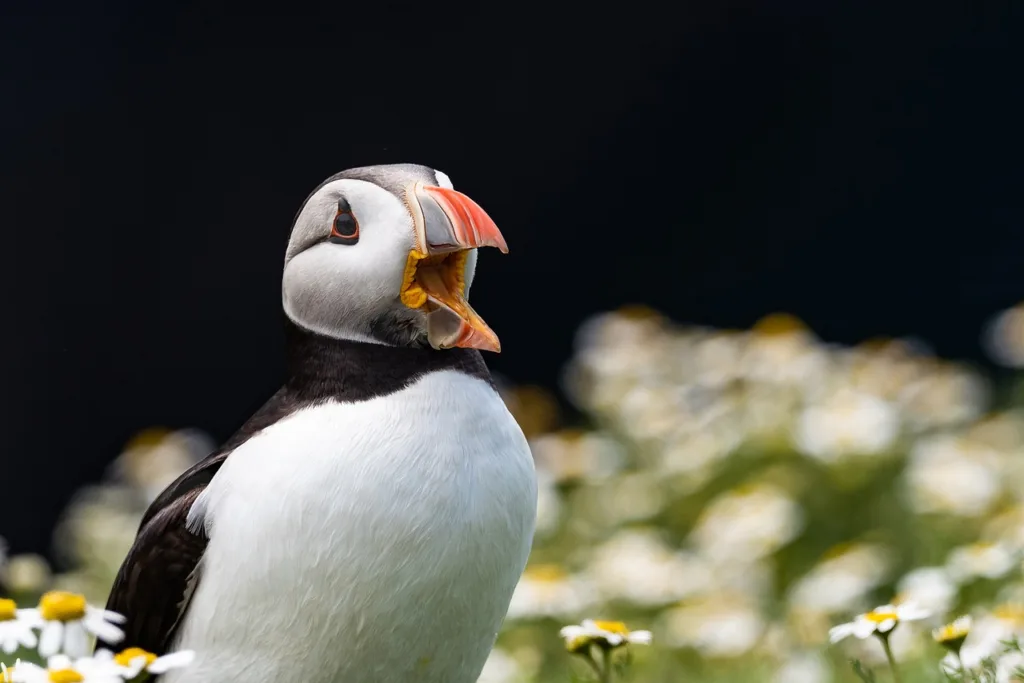
There are several ways you can support the conservation of Puffins in Newfoundland. Firstly, you can promote responsible tourism by following guidelines and respecting designated areas when visiting Puffin colonies. This helps minimize disturbance to the birds and their habitats. Additionally, you can contribute to conservation organizations that work to protect Puffins and their coastal ecosystems through donations or volunteer efforts. Raising awareness about the importance of Puffin conservation among friends, family, and the community can also make a positive impact. By collectively valuing and protecting these iconic seabirds, we can ensure their survival for future generations to enjoy.
Do Puffins migrate with their chicks in Newfoundland?
Puffins in Newfoundland do not migrate with their chicks. After the breeding season, when the chicks have fledged and can independently fly, adult Puffins and their offspring leave the nesting colonies. The adult Puffins migrate to the open ocean, where they spend the winter months. At the same time, the young Puffins embark on their first migratory journey, often travelling long distances to find suitable foraging grounds. Puffins are highly independent once the chicks fledge, and the adults do not provide parental care or guidance during migration. The young Puffins learn to navigate and survive on their own during this critical period.
How do Puffins find food in Newfoundland?
Puffins in Newfoundland find their food primarily by diving into the water to catch small fish and invertebrates. They have excellent underwater vision and can spot their prey from the surface. Once they locate their target, Puffins use their wings and webbed feet to propel themselves underwater, chasing the fish with their agile and streamlined bodies. Puffins can dive deep and remain submerged for up to a minute. They are skilled hunters and can catch multiple fish in a single dive. The diet of Puffins in Newfoundland mainly consists of small fish like capelin, herring, sand lance, crustaceans, and other marine organisms.
Are Puffins affected by climate change in Newfoundland?
Climate change can have indirect impacts on Puffins in Newfoundland. Rising sea temperatures can affect the distribution and abundance of the fish and invertebrates that Puffins rely on for food. If their prey becomes less available or shifts to new areas, Puffins may face challenges in finding sufficient food for themselves and their chicks. Climate change can also alter weather patterns, leading to intense storms, which can impact Puffin nesting sites and cause increased mortality rates. Protecting the coastal habitats, mitigating climate change, and ensuring sustainable fisheries management are crucial steps in safeguarding the future of Puffins in Newfoundland.
On a Boat trip in June, July or August, you may see dozens at one time.
If you go on a boat trip in June, July or August, you may see dozens of puffins simultaneously. During this time of year, puffins can be seen off the coast of Newfoundland with relative ease, and tourists on tours most commonly see them.
Atlantic Puffins are a type of seabird that lives in the Atlantic Ocean. There are many species of puffins, but only one lives off Newfoundland’s coast. In summer, puffins can be seen nesting on outcrops of offshore cliffs or islands, where they lay their eggs and raise their chicks before returning to sea.
Whales are mammals that spend most of their lives underwater but come up for air periodically throughout their journey through life, which lasts between 50-80 years. They migrate thousands of miles yearly following food sources such as krill or fish. This makes them highly adaptable creatures capable of surviving anywhere there is water, including oceans, rivers and lakes.
If you want a fantastic experience, book O’brien Whale Watching Tour. You will see both whales and puffins in Newfoundland, which many people dream about doing but have yet to get a chance at. This tour will give you that opportunity and more.
These are the best travel planning resources you should use.
Looking to book your trip to Newfoundland and Labrador? Use these resources that are tried and tested by other travellers like you who vacation in Newfoundland and Labrador. Bookmark these links. Save them for future reference.
Booking Flights, Hotels or B&B: Start planning your next vacation trip by finding the best flight, hotel or b&b deals. Book Here
Finding things to do in Newfoundland and Labrador on TripAdvisor and Viator is not hard. Enjoy boat tours, whale watching, icebergs watching, kayaking and other activities.
You can also find low prices on hotels, B&B and cabins with these two providers. If you are located in Canada, the USA, the UK or Europe, use Booking.com, and if you are in Canada, the USA or anywhere else, use TripAdvisor.
Car Rental: Here is what we recommend:
When you book with Rentalcars.com, you can compare prices and find the best vehicle for your trip. Economybookings.com Display all their vehicle on the website with a detailed description. They display high-quality photos and a user rating as well. Qeeq.com serves road trip travellers like you from different countries by working with car rental companies worldwide.
Get compensated if your flight is delayed or cancel
AirHelp and Compensateair will help you with flight delays, cancellations, or denied boarding. All you need to do is to submit your flight details, and they will handle the claim process on your behalf. They will handle all the paperwork, airline negotiations, and legal proceedings.
Do you need more help planning your trip?
Check out our Resources Page, where we highlight all the resources and companies you can use to assist with your planning.
Where can I find more information about travelling to Newfoundland and Labrador? Here are helpful resources for planning your trip:
Newfoundland and Labrador Tourism | Travel Canada | The Rooms Provincial Museum
